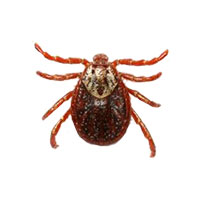Types of Crickets
Camel Crickets – Camel crickets owe their namesake to the humpback appearance. Adult camel crickets are commonly encountered indoors near moist areas like basements or near drainage pipes. The wingless adults can grow to over an inch in length and are known to damage fabrics.
House Crickets – House crickets are particularly skilled at surviving in residential homes and can spend their entire life inside a property. The nocturnal creatures are yellow and brown in color and have wings. House crickets are attracted to lights and can be seen swarming around exterior lighting.
Field Crickets – Field crickets are very common. A female field cricket can lay up to four hundred eggs. Field crickets will swarm when nymphs reach adulthood and fly off to mate. Swarms of field crickets can become problems for businesses when they swarm around buildings and become a nuisance to customers and employees.
Mole Crickets – Mole crickets are a concern for both homeowners and businesses as they are known to damage lawns and landscaping. Particularly proficient at digging, mole crickets will damage plants both by feeding on them and digging tunnels beneath the soil. Once mole crickets infest an area, predators like raccoons may be attracted to that area and dig up more holes in order to feed on the crickets.
Cricket Diet
Crickets are omnivorous insects that feed on a variety of different foods such as fruits, nectar, seeds, decaying organic materials, fungi, and seedling plants. Crickets have also been known to consume dead or weakened insects, including other crickets.
Cricket Habitat
Both house crickets and field crickets are found in tall grass, mulch piles, weeds, rock piles, and logs in the wild.
Cricket Life Cycle
Eggs
The mated females deposit their eggs in moist soil using a digging structure known as the ovipositor. Eggs are laid in groups of 50, with each female capable of laying up to 400 eggs in her lifetime. After a month, the eggs hatch into nymphs that look like adults without wings.
Nymphs
Nymphs pass through a simple metamorphosis and reach adulthood in 12 weeks.
Lifespan
The average lifespan of a cricket lasts between one week and three months.
Cricket Damage & Signs of Infestation
The field cricket and house cricket are not usually considered to be serious household pests, but they may feed on fabrics such as cotton, linen, silk, and wool, causing damage that can be severe, especially in cases of large infestations. Crickets tend to favor materials soiled by food or perspiration. On rare occasions, the pests may feed on crops and stored food, as well.
Trash
Crickets can frequently be found near garbage receptacles.
Moisture & Darkness
Crickets prefer darkness and areas of high moisture, which makes basements, crawlspaces, and even bathrooms attractive to insects.
Sound
The sound of males “singing” to attract a mate regularly signals the presence of the pests inside the home.
Lighting
Outdoors, crickets are often attracted to electrical lights, which may lead to accidental entry into homes and other structures.
Cricket Prevention & Control
Cricket Prevention
To prevent a cricket infestation, steps must be taken to discourage the pests from entering buildings in the first place.
- Leaks: As crickets are attracted to moist areas, fix all leaking pipes, direct runoff away from the home, and set up dehumidifiers in rooms that tend to accumulate excessive moisture such as crawlspaces and basements.
- Moisture: Keep areas dry and free of moisture, reducing humidity with a dehumidifier. Allow air to flow, keeping moisture, and pests out.
- Cracks: Seal off all cracks in building foundations and caulk areas around window sills and door jams to prevent accidental entry.
- Windows: Repair all torn window and door screens.
- Clean: Keep dark areas of the basement clean and clutter-free.
- Vegetation: Remove damp firewood, leaves, and excess vegetation from the perimeter.
- Nesting: Move wood, stone, and brick piles away from the house.
- Light: Eliminate attractant light sources.
Cricket Control
The short lifespan of crickets works in favor of homeowners, as the insects may not live long once they get inside the house. Sticky traps and other store-bought baits may work to draw crickets out and help control smaller infestations.
If a large cricket infestation occurs, count on a professional pest management service to take care of the problem knowledgeably and successfully.
What is the Difference Between Crickets and Grasshoppers?
- The main difference between a grasshopper and cricket is that crickets tend to have long antennae, grasshoppers have short antennae.
- Crickets sing by rubbing their wings together, while grasshoppers sing by rubbing their long hind legs against their wings.
- Grasshoppers detect sound by means of little ‘ears’ at the base of their abdomen; in crickets, these are on the front legs.
- Most crickets come out at dusk whereas grasshoppers tend to be out and about during the day.
- Grasshoppers mostly eat grass, but crickets are partial to the animal matter as well.
Need help with Crickets?
We'll call you! Leave your information below.



